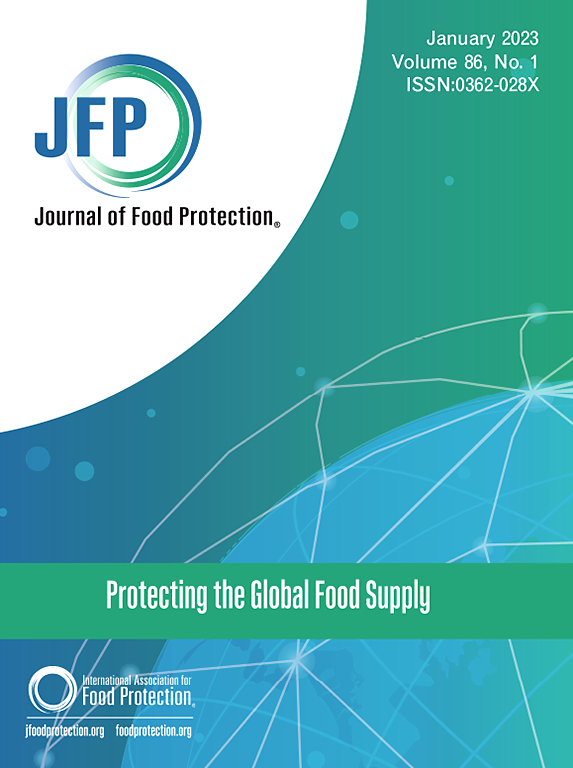Dried and Tested: Inoculation Method Impacts Low-Moisture Food Persistent Bacterial Populations
IF 2.1
4区 农林科学
Q3 BIOTECHNOLOGY & APPLIED MICROBIOLOGY
引用次数: 0
Abstract
Pathogen contamination and harborage in low-moisture food (LMF) processing environments have resulted in outbreaks and recalls, but researchers are limited in their abilities to investigate solutions. Methods used in most laboratory studies do not accurately reflect the route of contamination or harborage of pathogens in LMF environments, which complicates studying of sanitation methods. Inoculation methods were compared to establish low-moisture food persistent bacterial populations (LMF PBPs) that realistically reflect populations found in LMF environments. Culture-preparation techniques, food matrices, and ratios of nutrient to moisture were compared for their impacts on Salmonella Tennessee survival. A slurry method with 0.5 mL of culture to 0.4 g (NFDM) was easiest to form, inoculate, and process for further investigation, as was more consistent than other methods. With the chosen technique, LMF PBPs of Salmonella Tennessee (0.5: 0.4 [mL Salmonella Tennessee to g Powder]) with different powders (NFDM, peanut butter powder [PB], chicken powder [CP] and silicon dioxide [SiO2]) were made using lawn-based and broth-based cultures and distributed evenly on sterilized stainless-steel coupons to compare the impacts of preparation and food matrix on survival. Coupons stored at 22–25°C and 50% relative humidity (RH) were assessed on 0, 1, 3, 5, and 7 days. Matrices and culture preparation showed significant differences (p≤ 0.05). Salmonella LMF PBP derived from bacterial lawns demonstrated higher initial populations (10.1 ± 0.0 log CFU/cm2) compared to the broth cultures (8.2 ± 0.2 log CFU/cm2). Salmonella LMF PBP reductions were lower for the lawn-prepared cultures (0.3-2.7 log CFU/cm2) compared to broth-based cultures (1.0-5.1 log CFU/cm2) for all food matrices. Salmonella in LMF PBP with SiO2 (2.7-5.1 log CFU/cm2) reduced significantly more than in other food matrices (0.7-2.2 log CFU/cm2) and Sal without a matrix (0.3-1.5 log CFU/cm2) for both culturing methods.
求助全文
约1分钟内获得全文
求助全文
来源期刊

Journal of food protection
工程技术-生物工程与应用微生物
CiteScore
4.20
自引率
5.00%
发文量
296
审稿时长
2.5 months
期刊介绍:
The Journal of Food Protection® (JFP) is an international, monthly scientific journal in the English language published by the International Association for Food Protection (IAFP). JFP publishes research and review articles on all aspects of food protection and safety. Major emphases of JFP are placed on studies dealing with:
Tracking, detecting (including traditional, molecular, and real-time), inactivating, and controlling food-related hazards, including microorganisms (including antibiotic resistance), microbial (mycotoxins, seafood toxins) and non-microbial toxins (heavy metals, pesticides, veterinary drug residues, migrants from food packaging, and processing contaminants), allergens and pests (insects, rodents) in human food, pet food and animal feed throughout the food chain;
Microbiological food quality and traditional/novel methods to assay microbiological food quality;
Prevention of food-related hazards and food spoilage through food preservatives and thermal/non-thermal processes, including process validation;
Food fermentations and food-related probiotics;
Safe food handling practices during pre-harvest, harvest, post-harvest, distribution and consumption, including food safety education for retailers, foodservice, and consumers;
Risk assessments for food-related hazards;
Economic impact of food-related hazards, foodborne illness, food loss, food spoilage, and adulterated foods;
Food fraud, food authentication, food defense, and foodborne disease outbreak investigations.
 求助内容:
求助内容: 应助结果提醒方式:
应助结果提醒方式:


